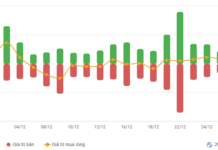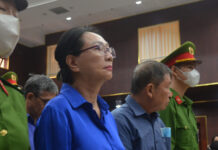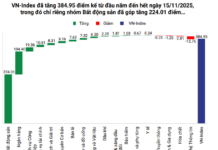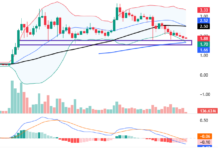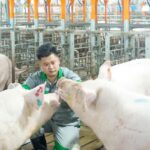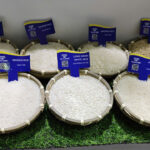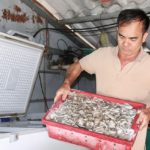According to the Statistics Bureau (Ministry of Finance), agricultural production in July 2025 focused on rice planting and tending, as well as cultivating crops for the summer-autumn crop. Simultaneously, vigorous and comprehensive measures were implemented to prevent and control the African swine fever effectively, protecting and developing the country’s livestock and poultry herds.
Forestry production mainly focused on afforestation and timber harvesting according to plans. Aquaculture continued to achieve fairly good results, while fisheries production slightly decreased due to the impact of the recent Storm No. 3.
DECREASE IN SUMMER-AUTUMN RICE AREA
According to data from the Statistics Bureau, as of July 20, 2025, the country planted 1,209,600 hectares of summer rice, a decrease of 10,500 hectares compared to the same period last year. The northern provinces accounted for 841,800 hectares, a decrease of 23,900 hectares.
This includes a decrease of 14,400 hectares in Bac Ninh due to a later growing season than the previous year, a decrease of 5,600 hectares in Hung Yen due to the conversion of part of the area for road construction and expansion of industrial zones, and a decrease of 5,400 hectares in Ninh Binh mainly due to land retrieval for industrial park construction projects.
The southern provinces, on the other hand, achieved 367,800 hectares, an increase of 13,300 hectares, as they were less affected by saltwater intrusion, encouraging farmers to actively plant the maximum area. Some localities with increased planting areas compared to the same period last year include An Giang with an increase of 6,100 hectares, Gia Lai with an increase of 4,200 hectares, and Ca Mau with an increase of 3,600 hectares.
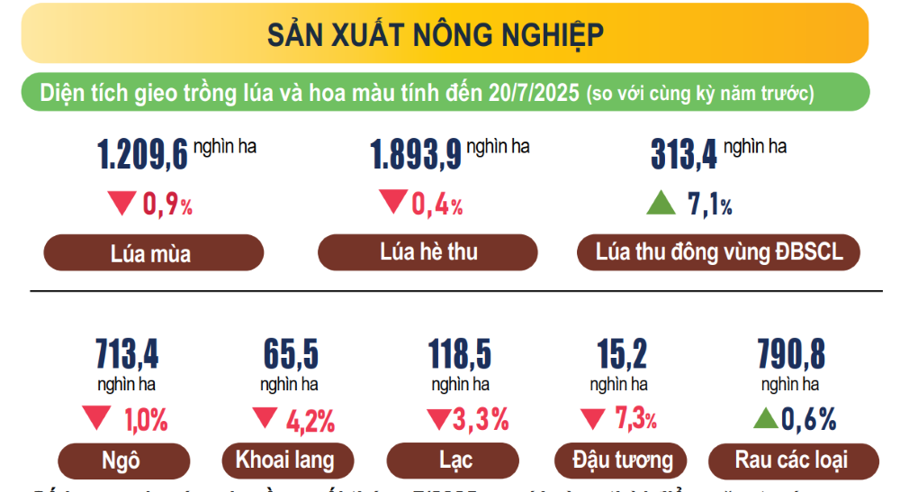
Regarding summer-autumn rice production, as of July 20, 2025, the country planted 1,893,900 hectares of summer-autumn rice, a decrease of 7,400 hectares compared to the same period last year. The northern provinces accounted for 172,500 hectares, a decrease of 1,500 hectares, while the southern provinces accounted for 1,721,400 hectares, a decrease of 5,900 hectares.
Some localities with significant decreases in area compared to the same period last year include Dong Thap with a decrease of 5,800 hectares, Vinh Long with a decrease of 1,700 hectares, and Can Tho with a decrease of 1,600 hectares. The summer-autumn rice is currently in a relatively good growth and development stage. As of now, the southern provinces have harvested 590,800 hectares of early summer-autumn rice, accounting for 34.3% of the planted area and 98.9% compared to the same period in 2024.
“As of July 31, 2025, the country has no more PRRS (Porcine Reproductive and Respiratory Syndrome). Avian influenza remains in Nghe An province, dermal nodule syndrome in Dak Lak and Dong Thap provinces, foot-and-mouth disease in Dak Lak province, and African swine fever in 31 localities that have not passed 21 days.”
Statistics Bureau.
Regarding the autumn rice crop, as of July 20, 2025, the southern provinces planted 313,400 hectares of early autumn rice, an increase of 20,800 hectares compared to the same period last year, mainly due to an increase in the area of early autumn rice on the basis of summer-autumn rice harvesting in some localities.
Among them, An Giang achieved 104,600 hectares, an increase of 24,900 hectares; Can Tho reached 83,300 hectares, an increase of 12,500 hectares; and Tay Ninh attained 40,000 hectares, an increase of 500 hectares. Currently, the autumn rice is in the tillering, heading, and growing stages, with good growth and development.
Along with rice planting, localities across the country are carrying out flower and colour crop planting. However, the area of some annual crops has decreased compared to the same period last year due to low economic efficiency.
In the livestock sector, the Statistics Bureau reported that buffalo and cattle farming continued the downward trend, mainly due to the shortage of roughage, high input costs, and unstable output prices, leading farmers to downsize or switch production forms. Pig farming faced difficulties due to the complex nature of the African swine fever, with 571 outbreaks and nearly 73,500 dead and culled pigs across the country, mainly occurring in small-scale farms and re-emerging from old outbreaks.
At present, localities are focusing on vigorously implementing measures to prevent, control, and effectively control the disease. Poultry farming has been stable thanks to low investment costs, utilization of available feed resources, and stable market demand for poultry meat and eggs.
AQUACULTURE PRODUCTION INCREASES BY 3.1%; TIMBER PRODUCTION RISES BY 7.6%
The area of new forests planted in the country in July 2025 is estimated at 13,500 hectares, a decrease of 1.6% compared to the same period last year, while the number of scattered forest trees reached 5.3 million, a decrease of 2.4%. In July 2025, the volume of timber exploitation reached 2,107,500 cubic meters, an increase of 5.9% as many localities exploited planted forests that reached the harvesting period.
In the first seven months of 2025, the area of new concentrated forest planting is estimated at 164,400 hectares, an increase of 15.1% compared to the same period last year, while the number of scattered forest trees reached 53.9 million, an increase of 2.1%. In the first seven months, the total volume of timber exploitation reached 13.2 million cubic meters, an increase of 7.6%.
The area of forest damage in July 2025 was 72.5 hectares, a decrease of 9.9% compared to the same period last year, of which the area of felled and destroyed forest was 58.7 hectares, an increase of 18.2%, and the area of forest fire was 13.8 hectares, a decrease of 55.1%. In the first seven months of 2025, the area of forest damage was 928.8 hectares, a decrease of 28.7% over the same period last year, of which the area of felled and destroyed forest was 631.8 hectares, an increase of 7.5%, and the area of forest fire was 297.0 hectares, a decrease of 58.5%.
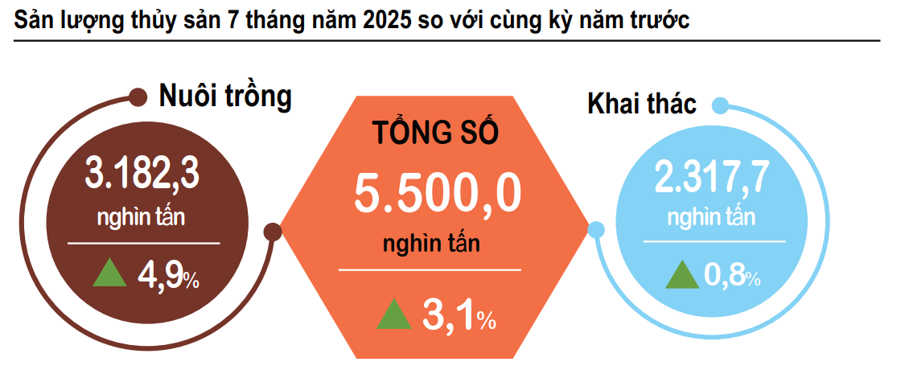
In the fisheries sector, the Statistics Bureau reported that the output of aquatic products in July 2025 is estimated at 949,300 tons, an increase of 3.0% over the same period last year. This includes: fish reaching 644,000 tons, an increase of 2.4%; shrimp attaining 188,000 tons, an increase of 5.7%; and other aquatic products amounting to 117,300 tons, an increase of 2.1%.
The output of aquaculture in July is estimated at 603,300 tons, an increase of 5.1% over the same period last year. This includes: fish reaching 368,900 tons, an increase of 4.5%; and shrimp accounting for 176,600 tons, an increase of 6.2%. The output of tra fish in July increased compared to the same period last year as farmers maintained stability in terms of area and output, with tra fish material reaching the harvesting period. The output of tra fish in July is estimated at 165,000 tons, an increase of 3.8% over the same period.
The output of shrimp in July 2025 increased compared to the same period last year due to the sustained high and stable prices of black tiger shrimp and the continuous increase in the price of white-legged shrimp. The output of white-legged shrimp in July is estimated at 139,200 tons, an increase of 7.0% over the same period last year, while the output of black tiger shrimp reached 30,000 tons, an increase of 2.9%.
The output of fisheries in July 2025 is estimated at 346,000 tons, a decrease of 0.3% over the same period last year. This includes: fish reaching 275,100 tons, a decrease of 0.3%; shrimp accounting for 11,400 tons, a decrease of 0.9%; and other aquatic products totaling 59,500 tons, a decrease of 0.5% due to the impact of Storm No. 3, which prevented fishing vessels from going to sea, thus reducing the catch. The output of marine fisheries in July is estimated at 333,200 tons, a decrease of 0.3% over the same period last year. This includes: fish reaching 265,000 tons, a decrease of 0.3%; shrimp accounting for 10,600 tons, a decrease of 0.9%; and other aquatic products totaling 57,600 tons, a decrease of 0.3% compared to July 2024.
In the first seven months of 2025, the output of aquatic products is estimated at 5,500,000 tons, an increase of 3.1% over the same period last year. This includes: fish reaching 3,925,700 tons, an increase of 2.8%; shrimp accounting for 793,400 tons, an increase of 5.6%; and other aquatic products totaling 780,900 tons, an increase of 2.0% over the same period.
“France-sourced Pigs Power BAF’s Ambitious 10 Million Pig Plan for 2030”
Amid the challenging ASF situation, BAF Vietnam Agriculture Joint Stock Company (HOSE: BAF) has imported a significant number of great-grandparent pigs from France for the Central Highlands region. This move aligns with the company’s ambitious goal of reaching 10 million commercial pigs by 2030. The Central Highlands is a key area in BAF’s strategy to expand its pig population, thanks to its favorable climate and vast land area, which are ideal for large-scale, closed-system farm models.
The Miracle Cure: Vietnamese Scientists Discover African Swine Fever Vaccine
The veterinary industry in Vietnam is proud to have invented an African Swine Fever (ASF) vaccine, a feat that has eluded the world for a century. Vietnam’s success in developing this vaccine has gained recognition from numerous countries. However, the mastermind behind this ASF vaccine is a young Vietnamese scientist who quietly achieved this impressive feat, unbeknownst to many.
Unlocking Vietnam’s Rice Export Miracle
This year, Vietnam is expected to export approximately 9 million tons of rice, a record-breaking figure despite no increase in cultivation area or yield.
The Quiet Achiever: A Farmer’s Simple Ways Reap Him a Fortune
After years of working as a hired laborer, farmer Tran Van Dung took a bold step and invested in an unusual venture. His passion for swimming and his unwavering determination led him to a unique business idea that has brought him remarkable success. With a keen eye for opportunity, he has turned his love for the water into a thriving enterprise, reaping profits of hundreds of millions of dong annually.

